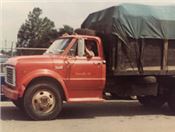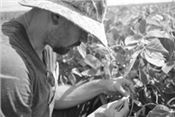|
Reflections

My Dad, Ralph Stevens, drives his truck to haul soybeans to market.
DR. GENE STEVENS
PORTAGEVILLE, MO.
This article is the second in a series on my childhood experiences on our family farm in Tennessee and my work at the University of Missouri and Mississippi State University.
My dad, Ralph Stevens, served in the Navy during World War II. When he returned to the farm, he began planting soybeans for hay to feed his cows. Then, as prices increased in the late 1960’s, he harvested soybeans for grain with a combine and sold them at the Continental Elevator near the Mississippi River in Memphis, Tennessee.
During the winter when Dad was working around the farm, he wore old pants and an army surplus coat over his good clothes. The outer clothes were ragged and stained by cow manure from the dairy barn and grease from cotton pickers. He wore clean clothes and his newest John Deere or International Harvester cap for trips to “town”.
Late one day he asked me to ride with him to haul a load of soybeans in his GMC dump truck. As usual he peeled off his outer layer of clothes and put them on the seat between us. On the way, we stopped at a market vendor under a street overpass and bought a sack of tangerines. I was hungry and ate so many of them that I almost got sick.
Several railroad tracks cross the streets near the grain elevator. A long line of trucks was in front of us and Dad eased off of the clutch as we moved slowly forward bumping across the railroad tracks. Dad recognized a farmer friend from Fayette County in front of us.
Unfortunately, the farmer was not as careful as Dad. His sideboards jumped up when he crossed the tracks. The farmer watched in horror as soybeans spilled through the cracks of his sideboards onto the street. We rushed out of our truck and Dad pitched him his old pants and coat to stuff into the cracks. The farmer ripped Dad’s clothes into shreds to fill the holes where the side boards separated. He probably thought they were rags. As we got back in the truck, Dad laughed and said he needed to buy another set of clothes anyway.
I still remember that soybeans sold for the crazy of price of $11 per bushel in May, 1973. Factors such as adverse weather, depreciation of the dollar, and large purchases by the Soviet Union caused spikes in soybean prices. But farmers’ profits were limited because soybeans typically produced only 18 to 20 bushels per acre.
Public and private breeders have done a tremendous job increasing the yield potential of soybean varieties in the last 50 years. Dad grew soybeans named after Civil War generals (ex. Lee, Bragg, Forrest) bred by Dr. Edgar Hartwig. I later became friends with Dr. Hartwig when I worked as an agronomist for Mississippi State University at the experiment station in Holly Springs, Mississippi. Surprisingly, he worked into his 80’s. During lunch breaks Dr. Hartwig told me stories about collecting soybean germplasm in exotic places in Southeast Asia.
In the last two decades, I have watched Dr. Grover Shannon and Dr. Pengyin Chen and their support staff at the University of Missouri in Portageville, Missouri breed new soybean varieties.
Plant breeding is a numbers game. On average, less than 1 in 10,000 progeny (offspring) from soybean crosses make it to the finish line. The breeding staff make 100s of crosses and screen over 50,000 progeny each year. In 2020, eight made the cut for release as new University of Missouri soybean germplasms. Many years none are good enough to be released. The releases have traits for higher yield with resistance packages for SCN, Root knot, and Reniform nematodes, Stem Canker, Phytophthora root rot, Charcoal rot, and Sudden Death Syndrome. I am most impressed with S16-5540R which placed number one in the USDA Regional Trials. Most of the lines that were not released were discarded as “junk”.
In today’s world of patented gene traits and licensing agreements, a farmer cannot track a new public soybean release to commercial seeds. When a company buys the rights to a public line, they give it their own brand name. I have heard farmers say, “We don’t need university breeding programs anymore.” Ironically the same farmers may be planting soybean genetics from a university breeding program and not even know it. In the future, I would like to see more transparency in this process. Seed sacks should have a tag or stamp showing the public breeder, university, and original name. To learn more about new soybean lines bred at the MU Fisher Delta Research Center go to https://delta.missouri.edu/field-day/. ∆
DR. GENE STEVENS: Professor Cropping Systems, Division of Plant Sciences, Fisher Delta Research Center, University of Missouri

A worker makes a soybean cross at the University of Missouri-Fisher Delta Research Center in Portageville, Missouri
|
|